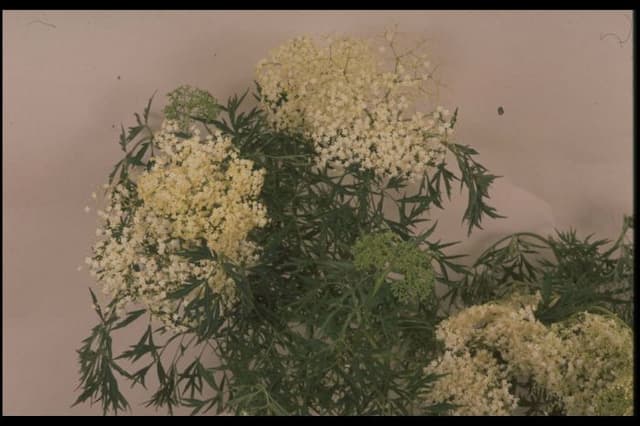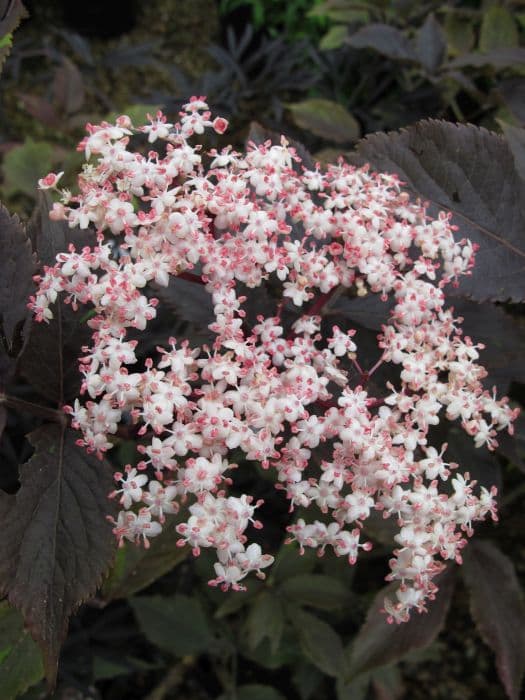Leatherleaf Viburnum Viburnum rhytidophyllum

ABOUT
The plant known commonly as leatherleaf viburnum has a striking appearance with features that make it quite recognizable in the landscape. The leaves of this plant are one of its most distinctive traits; they are long and broad with a deep green color on the top surface and a slightly paler shade underneath. Texturally, the leaves are leathery and wrinkled, which is hinted at by the plant's common name. They have a robust and somewhat rough feel, with deep veins that create a crinkled appearance, almost like corrugated cardboard. In contrast to the coarse leaves are the blossoms that emerge on the plant. The flower clusters are creamy-white and form in spring. They appear as flat-topped clusters that offer a soft visual texture. These flowers can add a subtle fragrance to the area around them, making the leatherleaf viburnum not only a treat for the eyes but for the nose as well. Following the flowering season, leatherleaf viburnum produces fruits that transition in color as they mature. Initially green, they gradually turn to red and eventually darken to a black shade upon full ripeness. The fruits are a point of interest for wildlife, particularly birds, which may be attracted to the plant for this reason. Overall, the contrasting features of robust, wrinkled leaves against delicate-looking flowers and the evolving fruit colors contribute to the appealing and varied visual interest of the leatherleaf viburnum throughout the growing season.
About this plant
 Names
NamesFamily
Adoxaceae
Synonyms
Leatherleaf Viburnum, Wrinkled Viburnum, Wrinkled Leaf Viburnum, Reddish Viburnum
Common names
Viburnum rhytidophyllum
 Toxicity
ToxicityTo humans
Leatherleaf viburnum (Viburnum rhytidophyllum) is not generally considered toxic to humans. However, as with many plants, it may cause mild stomach upset if ingested in large quantities. It is important to note that individual reactions can vary, and while not considered highly toxic, it is still not advisable to ingest parts of this plant. If accidental ingestion occurs and symptoms appear, seeking medical advice is recommended.
To pets
Leatherleaf viburnum (Viburnum rhytidophyllum) is generally considered to have a low toxicity risk for pets. Nonetheless, ingestion of plant parts may cause mild to moderate gastrointestinal upset in some animals, such as vomiting or diarrhea. If a pet ingests a large amount of the plant and exhibits symptoms, it is advisable to consult with a veterinarian. Each animal may react differently, and while serious toxicity is not commonly reported, caution should be maintained to prevent pets from ingesting plants.
 Characteristics
CharacteristicsLife cycle
Perennials
Foliage type
Evergreen
Color of leaves
Green
Flower color
White
Height
8-12 feet (2.4-3.7 meters)
Spread
8-12 feet (2.4-3.7 meters)
Plant type
Shrub
Hardiness zones
5-8
Native area
China
Benefits
 General Benefits
General Benefits- Ornamental Value: Viburnum rhytidophyllum, commonly known as leatherleaf viburnum, is appreciated for its aesthetic appeal in gardens and landscapes.
- Low Maintenance: Once established, leatherleaf viburnum requires minimal upkeep, making it suitable for gardeners seeking low-maintenance options.
- Wildlife Attraction: The plant produces berries that are a food source for birds and flowers that can attract pollinators like bees and butterflies.
- Privacy Screen: With its dense foliage, leatherleaf viburnum can be planted as a hedge or privacy screen to create secluded areas in gardens and outdoor spaces.
- Seasonal Interest: Leatherleaf viburnum offers year-round interest with its evergreen leaves, spring flowers, and autumn berries.
- Drought Tolerance: Once established, the plant is quite tolerant of dry conditions, making it a good choice for gardens in regions with water restrictions.
- Versatility: It can be used in various landscape designs, including formal and informal gardens, mass plantings, or as a specimen plant.
- Windbreak: The shrub can serve as a windbreak when planted in groups, helping to protect more delicate plants and reduce wind erosion in landscapes.
 Medical Properties
Medical PropertiesThis plant is not used for medical purposes.
 Air-purifying Qualities
Air-purifying QualitiesThis plant is not specifically known for air purifying qualities.
 Other Uses
Other Uses- Leatherleaf Viburnum hedges can provide a dense screen for privacy or windbreak in landscapes due to its thick foliage.
- The textured leaves of the Leatherleaf Viburnum can add interesting contrast and tactile variety in sensory gardens.
- Its robust, evergreen nature allows it to be used to prevent soil erosion on slopes or banks.
- The shrub can serve as a backdrop for flower beds, complementing more colorful plantings with its deep green leaves.
- Leatherleaf Viburnum’s sturdy branches can be used in creating rustic, natural fencing or barriers in a garden setting.
- The plant can act as a noise barrier when planted densely along roadsides or in urban settings.
- Birds are attracted to its berries, so the shrub can be used to create a wildlife-friendly garden or to support local bird populations.
- The long-lasting, leathery leaves can be used in floral arrangements as a green, structural element.
- Incorporated into a xeriscape garden design, Leatherleaf Viburnum can tolerate periods of dryness once established and reduce water use.
- Its dense growth habit can be utilized to cast shade over smaller shade-loving underplantings, protecting them from harsh sunlight.
Interesting Facts
 Feng Shui
Feng ShuiThe Leatherleaf Viburnum is not used in Feng Shui practice.
 Zodiac Sign Compitability
Zodiac Sign CompitabilityThe Leatherleaf Viburnum is not used in astrology practice.
 Plant Symbolism
Plant Symbolism- Renewal: The Viburnum rhytidophyllum, commonly known as the Leatherleaf Viburnum, typically symbolizes renewal because it is a perennial shrub that rejuvenates each year and can easily revive itself after harsh conditions.
- Protection: This plant's thick leaves can symbolize protection, as they provide shelter for wildlife, reflecting the idea of safety and refuge.
- Persistence: The Leatherleaf Viburnum's ability to adapt and persist in various soil types and climates represents tenacity and the ability to thrive in diverse conditions.
- Abundance: Its generous clusters of berries suggest abundance and prosperity, which can be seen as a symbol of fertility and plenty.
 Water
WaterLeatherleaf Viburnum should be watered deeply about once a week, allowing the soil to dry slightly between watering sessions. During the first growing season, establish a good root system with regular watering of about 1-2 gallons depending on the size of the plant. Once established, they are quite drought-tolerant and may require less frequent watering, depending on weather conditions. During hot or dry spells, weekly watering may still be necessary, especially for plants in full sun. Make sure to water at the base of the plant to avoid wetting the foliage, which can lead to fungal diseases.
 Light
LightLeatherleaf Viburnum thrives in a location with full sun to partial shade. It can tolerate various lighting conditions but prefers a spot where it can receive at least four hours of direct sunlight each day. Ensure that the chosen spot receives morning sun, which is gentler, and provides some protection from the intense afternoon sun, especially in hotter climates.
 Temperature
TemperatureLeatherleaf Viburnum is hardy in temperatures as low as -20 degrees Fahrenheit and can tolerate summer temperatures well into the 90s. The ideal temperature range for this Viburnum would be between 30 and 80 degrees Fahrenheit. It's a resilient shrub that adapts to a variety of climate conditions but should be protected from extreme temperature fluctuations.
 Pruning
PruningLeatherleaf Viburnum benefits from pruning to maintain its shape, encourage bushiness, and remove any damaged or diseased branches. The best time to prune is late winter or early spring before new growth starts. Prune sparingly, as this plant naturally forms an attractive shape, and over-pruning can reduce flower production. Remove older branches to encourage new growth if the plant becomes too dense.
 Cleaning
CleaningAs needed
 Soil
SoilLeatherleaf Viburnum thrives in moist, well-drained soil that is rich in organic matter. The ideal soil pH for Leatherleaf Viburnum should be slightly acidic to neutral, ranging from 5.6 to 7.0. To create the best soil mix, combine garden soil with compost and peat moss to enhance fertility and drainage.
 Repotting
RepottingLeatherleaf Viburnum, being a relatively large shrub, is not commonly repotted. It's typically planted directly in the ground where it can spread. If grown in a container, repot every 3-5 years in the spring to refresh the soil and give roots more room to grow.
 Humidity & Misting
Humidity & MistingLeatherleaf Viburnum does well in average garden humidity levels. They do not require special humidity conditions and are adaptable to the moisture levels found in most garden environments.
 Suitable locations
Suitable locationsIndoor
Provide bright light, keep soil moist, and ensure good airflow.
Outdoor
Plant in partial shade, shelter from wind, enrich soil with compost.
Hardiness zone
5-8 USDA
 Life cycle
Life cycleViburnum rhytidophyllum, commonly known as leatherleaf viburnum, begins its life cycle as a seed that germinates in moist, well-drained soil, usually in partial to full shade. The seedling grows into a young plant with wrinkled, evergreen leaves and a robust root system. As the plant matures, it develops into a large shrub, reaching heights of up to 10-15 feet with a similar spread. During spring, the leatherleaf viburnum produces white, fragrant flowers that are arranged in flat-topped clusters, leading to pollination and the development of red to black berries by late summer into fall. These berries are a food source for birds and wildlife, and they can also facilitate the spread of seeds to new locations. Over time, the shrub can reproduce via suckers, expanding vegetatively to form colonies.
 Propogation
PropogationPropogation time
Spring to Summer
Propogation: The Leatherleaf Viburnum is a species easily propagated by semi-ripe cuttings taken in late summer. To do this, you want to select a healthy branch that has new growth but has started to harden. Cuttings should be about 6 inches (15 centimeters) long with several leaves. The bottom end of the cutting is dipped into a rooting hormone to enhance root development and then planted into a pot filled with a mixture of peat and perlite or sand to provide good drainage. The cutting should be kept in a humid and warm environment until roots have established, which usually takes several weeks. It's important to keep the soil moist but not overly wet during this period. Once rooted, the new Leatherleaf Viburnum can be transplanted to a more permanent location outdoors.









